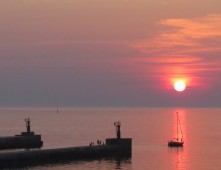VĒRGALE, ZIEMUPE,SARAIĶI
History of VĒRGALE parish
Vērgale is located 30km to the north from Liepāja. It spreads mainly in the plain coastal lowland, its eastern part juts into the heights of western Kurzeme. About a half of the territory is covered by woods rich in plants and wild animals. On the coast of the sea there is Ziemupe Botanical Nature Reserve with a lot of protected plant species. There are a lot of great trees and Ziemupe juniper forest in the parish. Vērgale parish borders with the Baltic Sea, as well as Medze, Dunalka and Saka parishes. Vērgale with the name “Virgenare” has been mentioned for the first time in 1253 in Kurzeme partition agreement between Kurzeme bishop and the German Order. The information exists that the territory of Vērgale has been let out to Villekin and it has later been owned by Bertold Stein according to Kuldīga comturia and then by Gothard Ketler , Gerhard von Nolde who was a son of G. fon. Nolde, in 1612 Vērgale was sold to Heinrich von Sacken who sold the estate to Georg von Behr after the death of Landrate Friedrich von Sacken in 1722. In 1920 he lost the estate and it was taken in possession by the state. Vērgale parish was established in 1877. Just before the First World War it was joined to Medze parish and became independent during existence of the first Republic of Latvia. During Soviet times Ziemupe parish was joined to Vērgale parish, as well as a part of Tāši and Medze. In 1947, the first collective farm “Zelta Druva” was established in Vērgale, Liepāja district. In the same way, collective farms “Uzvara” and “Jaunais ceļš” were founded in 1948. In the 50-ties they were united and the collective farm “Ļeņina ceļš” was established which became a strong farm. In the same year the collective farm “Kaija” was founded in Ziemupe, as well as the collective farm “Kopdarbs” in Saraiķi. Later both of them joined together in the collective farm “Kopdarbs”.
There are 4 libraries, Vērgale Recreation Centre, Ziemupe Village Hall in the parish. The dance group “Vērgalīte” is the most active because it has participated in all Latvian General Song and Dance Festivals, the senior group “Vakarvējš” is also well-known, as well as sportsmen of Vērgale parish.
In 1995, Vērgale obtained the name of the tidiest parish in Kurzeme. Famous archaeological sites - Elka Hill – Castle Mound, Ošenieki ancient burial site at the former Ošenieki half of manor dates back to the 5th century B.C., BruņeniekI ancient burial site (Zviedru Cemetery), Mazkalni medieval cemetery at the house Mazkalni. Architectural monuments of local importance – Ziemupe church, Saraiķi church, Vērgale church, Mazkaži living house, servant house Dangaskalni, Vērgale estate complex. The school in Vērgale was founded around 1780-1790, when the innkeeper Raudīte who was also a church organist taught the young people to be confirmed. The first school building was built in 1828. The school existed in the building until October 26, 1922, afterwards it moved to Vērgale Manor House.
Tourism is considerably developed in Vērgale. There is a Santa Claus office in Ziemupe. The museum founder Alfrēds Šnipke (1932 – 2005) has made a great contribution to the history of Vērgale, as well as written the books “Vērgale Through Times” and “ Vērgale Through Times 2”.
In 2009, Pāvilosta region was established by joining together Vērgale parish with Saka region.

Vērgale Manor Buildings Complex
+371 29338335
The manor house was built as a hunting castle of Ugāle baron von Behr in 1797. The second floor was built in 1837. It is constructed as a two-floor long structure with a high socle floor, four-slope roof and two four-column porticoes in the frontons of which the coat of arms of the Behr family and decorative rosettes were placed. The manor house is the most significant Empire style object in the former Liepāja district. At present, Vērgale Primary School is located in the building. A remarkable place is Vērgale Manor House Park within the area of 4 ha where the planted rows of trees form a regular pattern. The park is historically significant – in 1905, several insurgents of Vērgale were tied to the park trees who were shot by the punitive expedition under the guidance of count Keizerling. A library is situated in the servant house and a recreation centre in the former barn. A parish board is located in the superintendent’s flat.
The Vērgale manor buildings ensemble is one of the most peculiar empire style manor complexes in Kurzeme.
Photo: Varis Sants
Vērgale parish History Museum
“Dīķenieki", Vērgale
+371 29338335
sipola.mirdza@inbox.lv
It is located in one of the buildings of Vērgale manor house complex, the former distillery. After reconstruction the museum was opened in March, 1992. More than 3000 museum objects are stored in the collection. The most valuable exhibits are the ancient tools – stone axes, archaeological materials from the local excavations – ancient bronze jewelry. One of the biggest mantel chimneys in Kurzeme has remained in the building – an open-fire hearth for cooking where the smoke is discharged from the room through the open chimney passage.
Working hours:
2.09.-31.05 Mon-Fri 9:30-16:30
Sat, Sun - closed
1.06.- 01.09. Wed-Sun 9:30-16:30,
Mon, Tue - closed
at other times – by prior appointment
Entrance fee:
School pupils € 0,25
Students, senior citizens € 0,50
Adults € 0,70
Guide services in Vērgale parish area, per tour 5,00 €
Vērgale ev. lut. Church, Cemetery and
Monument to the Lovers
+371 29338335
The church was founded in 1597. The first stone building might be built at the end of the 17th century. Under the church there was a crypt which was filled up in 1841 when Vērgale church was reconstructed. In 1985, the church was torn down. It was built anew in 1992.
There is a cemetery around the church. The words "We could not otherwise..." are inscribed on some memorial tablet. Any person living in Vērgale will be able to tell you the tragic story of the lovers – the son of baron Stempelis and the maid Anna Lazdiņa.
ZIEMUPE
Ziemupe is a small populated area at the coast of Baltic Sea. The first records of Ziemupe date back to 1422. Until 1954 it has existed as Ziemupe parish, then joined to Vērgale parish and just now to Pāvilosta region. Our treasure- the silent, virgin, severe Ziemupe seashore rich in rare plants. The power of Ziemupe is rustle of the sea and heathbells, sincere and hospitable people. Visit us and make sure yoursalf! You will get to Ziemupe if you go along the road Liepāja- Ventspils and turn to the sea in 27km.
Exposition “Story of Swordfish”
in "Jūras māja"
"Jūras māja", Ziemupe, Vērgale parish
+37129437166
daina.vitola@pavilosta.lv
A swordfish was washed ashore in Ziemupe seashore on August 12, 2007. The fish of this species are typical ocean fish and rarely encountered in the Baltic Sea. A swordfish was 2.08m tall and weighed 37kg, its upper jaw extension or “sword” was about 70cm long. Specialists have found out that the swordship is about 10 years old. The main exhibit of the exposition is its mullage made by the artists K.Panteļejevs and I.Lapiņa of the creative group “Three Nutmegs”.


KulTūrBode (Ziemupe Cultural Shop)
Ziemupes tautas nams
+371 26338229
ziemupiite@inbox.lv
KulTūrBode- is the store, meeting place in the center of Ziemupe. A place where you can stay, meet, shop, engage, experience.
KutTūrBode is diverse and varies depending on the season.
What is the Ziemupe Cultura Shop?
Kult(knock down)- we all know the story of a frog that, without giving up, knocked cream into butter. To get bread, you need to thresh the grain. Kultūr- culture, the totality of human- created values. Tūr- tourism, communication with nature, traveling. And Bode (kiosk)- a place for buying and selling.
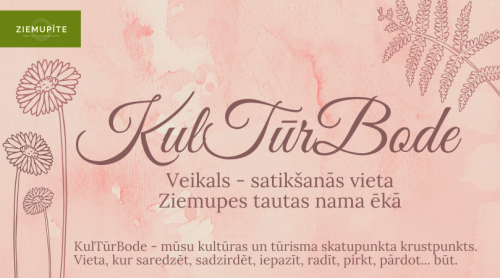
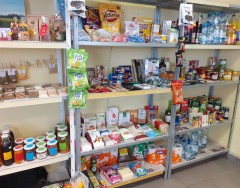
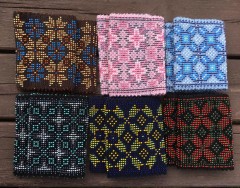
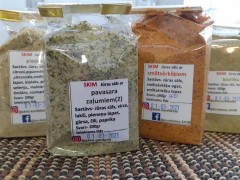
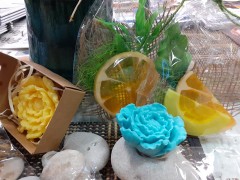
Ziemupe Church
+371 26274155
(entrance with donations)
Ziemupe Evangelical Lutheran Church is special among Kurzeme churches due to its small dimensions (25x11m) and architectonic simplicity because it even does not have a bell-tower. Originally, it was a wooden church, its altar was made in 1684 which is one of the earliest decorative sculpture samples having developed baroque characteristic marks. Therefore its wood-engravings and paintings play an important role regarding Kurzeme decorative art. The stone church was built in 1748. There is a musical instrument in the church – a harmonium made in the 20-ties by the company of J.Bokums who is the most well-known harmonium producers in Latvia.

Specially protected nature reserve Ziemupe
+371 29437166
(the nature Reserve may be visited together with the local guide)
It was established in 1999 and now its area is 2469ha. The Nature Reserve contains woods with a lot of Myrica stands and seashore from Ziemupe to Rudupe. You will find a lot of interesting plants in the dunes – a common moonwort, Dutchman’s pipe and salsify. If you succeed, you will also meet an insect – an antlion. You will have a possibility to enjoy natural moss patterns.Being an important natural area in Europe, the natural reserve Ziemupe has been included in the NATURA 2000 area network. It is one of the few and best areas where grey dunes are protected in Latvia. Sea holly is depicted in the coat of arms os the Pavilosta region.
Millitary troops No. 90450 P
In Soviet times to guard the major Karosta Liepāja millitary base from possible attacts of imperialists, Zenit rocket divisions were deployed along the sea shore ( at that time, the UssR border)every 25 km. Millitary troops No. 90450 P were deployed here. The location of Ziemupe, being the border of the great USSR, was guarded from yhe sea, in the air, and along the sea shore.


Memorial plaque to the sailing vessel Moscow
During a severe storm on 7 October 1758, the battleship with 66 cannons Moscow (length – 46 metres, width – 12 metres) crashed in the Baltic Sea opposite the location of Ziemupe. A crew of 600 mariners was aboard the vessel. The vessel was out of control due to various areas of significant damage. During the storm, the falling spars destroyed lifeboats, therefore, the crew had to get to shore on self-made rafts. On 10 October, the remaining crew was brought to shore on several already-made boats at Ziemupe. The following day, the storm broke the stranded sailing vessel in half. The food sank along with the vessel. Ninety-eight mariners perished from cold and starvation.
On 25 July 2010, 252 years later, a plaque in memory of the mariners who died was installed at the seashore of Ziemupe.
Aužuļi lime-tree
The fourth greatest lime-tree in Latvia (7,65 m) has obtained its name in honour of Aužuļi home where it has grown. This home does not exist already for a long time. The lime-tree could be about 380 years old. It has been severely destroyed in the storm of 2005. A new lime-tree was planted near the great lime-tree on May 9, 2007.
Man-made cairns
Earlier when the seashore was not afforested the attack of the sea sand to agricultural lands did great harm to the population. In order to block up the sand, people living in Ziemupe made a long stone load. It is one of the versions how the stone load longer than a kilometre was made.
Steep Coast at Ziemupe
+371 29437166
Its height ranges from 5 to 12m. During the last years the sea has taken a more than 10m wide area from the land. There is a really original flora in the dunes which you can view together with a guide.

Christmas village "Rūķupe"
+371 29122204
Ziemupes jūrmalas stāvlaukums
(you are requested to register your visit in advance by calling)
Rūķupe (Dwarf River) is a place at the Ziemupe seaside which has not originated either yesterday or today; it has existed forever. Various Dwarfs reside here, and legends about their life are spread from ancient times, yet it becomes visible only in December. The Head Dwarf of the Rūķupe in the recent centuries is the Father Christmas. This is the place where you can sense Goodness, Affection and True Joy of Being Together. The pony Kriksis merrily hops around the largest Dwarfs; the smell of the warm Dwarf tee always deliciously floats over the forests; a Book of the Good Deeds is always displayed in an honorary place.
Rūķupe is a place where all letters addressed to the Father Christmas from Latvia come to. More and more often they come also from far away - Russia, Germany, England, China, Taiwan, the Czech Republic, Ukraine, France and many other countries! The Father Christmas carefully reads them and prepare a response that is especially crafted for each person. A number of letters increases with each year and can be measured in hundreds (not the Dwarf hats). They all are carefully archived and stored in a Safe Place - in the Large Letter Cabinet.
Rūķupe is a place where good creates good, and the world becomes many times lighter. The dwarfs each year organize a charity campaign “Let’s Fill the Large Sack of Presents!” with a participation of big and small preparers of presents from the entire Kurzeme. The Dwarf Motivation Brigade collects them in person, place in groups, and via the workers of social services deliver to lonely people and families experiencing hardships during this stage of life as a Ray of Hope.
Rūķupe is more than a village. It represents Values, Co-responsibility, Joy, Time We Dedicate to Each Other, Care, Friendship and Much More!


Garden of soul relief of Ziemupe
Laivenieki, Ziemupe
+371 22007874
info@redzigaismu.lv
www.redzigaismu.lv
While visiting Pāvilosta, don’t forget to take a trip to Ziemupe; located 31.8 km away in rural environment, it is a home to Soul Relieve Garden – the social rehabilitation and cognitive centre for people with disabilities and everyone concerned, established by Liepaja Society of the Blind. In summer, a labyrinth and a fruit orchard of the centre greet their visitors with cheerful bird singing and offer an opportunity to enjoy the Barefoot Trail through the woods and and enchanting scent of flowers in the Sensation Park, and in winter cold everyone can have a pleasure of hot linden – blossom tea and warmth of fire in the hall with a fireplace. During a visit to Soul Relieve Garden, you can participiate in recreational activities, enjoy swimming in a pond next to the building and join garden and farm works, as well as taste homegrown vegetables and fruits.
Nature trails in Soul Refreshment garden
There are three short natural trails in Liepaja Blind Society Centre that are specially adapted for visually impaired and blind people - Barefoot trail, Park of Senses and Labyrinth. In the nearest wood there is a 530 m long Barefoot trail the covering of which changes every 10 metres as well as obstacles with different degree of difficulty. There is also an ornamental bush labyrinth already stretching towards the sun that spreads throughout an area of 800 m2 . Park of Senses gives you the opportunity to experience a great variety of different plants – to touch, taste, smell them and even to weed some of them. Plant beds have been purposefully made at a higher level so that people in wheelchairs could get close to them.


SARAIĶI
Saraiķi ev. lut. Church
+371 25986244
(You are requested to register your visit in advance, entrance with donations)
It was built at the end of the16th century which is testified by its two bells made in 1594 and 1602. The church was destroyed during the Great Nordic War. It was restored and dedicated on October 17, 1798 upon the wish of Saraiķi serf-owner, baron Peter Jurgis Zigmund Offenberg – “In honour of God and for the benefit of Zaraiķi people.”
Māsku Oak
Its perimeter is 5,49 and height 22 m.


































